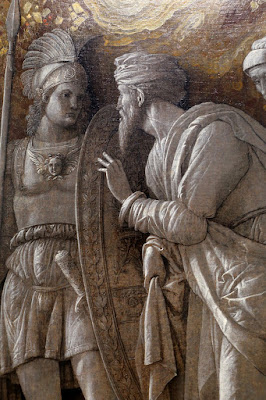 |
| Andrea Mantegna Minerva expelling the Vices from the Garden of Virtue (detail) 1502 tempera and oil on canvas Musée du Louvre |
 |
| Andrea Mantegna Minerva expelling the Vices from the Garden of Virtue (detail) 1502 tempera and oil on canvas Musée du Louvre |
 |
| Andrea Mantegna Minerva expelling the Vices from the Garden of Virtue (detail) 1502 tempera and oil on canvas Musée du Louvre |
 |
| Andrea Mantegna Samson and Delilah ca. 1495-1506 distemper on canvas National Gallery, London |
 |
| Andrea Mantegna Introduction of the Cult of Cybele at Rome ca. 1505-1506 distemper on canvas National Gallery, London |
 |
| Andrea Mantegna Introduction of the Cult of Cybele (detail) ca. 1505-1506 distemper on canvas National Gallery, London |
 |
| Andrea Mantegna Introduction of the Cult of Cybele (detail) ca. 1505-1506 distemper on canvas National Gallery, London |
 |
| Andrea Mantegna Introduction of the Cult of Cybele (detail) ca. 1505-1506 distemper on canvas National Gallery, London |
 |
| Andrea Mantegna Holy Family with St John the Baptist ca. 1500 distemper on canvas National Gallery, London |
 |
| Andrea Mantegna Holy Family with Mary Magdalen (Castelvecchio Madonna) 1495 tempera on canvas Museo di Castelvecchio, Verona |
 |
| Andrea Mantegna Holy Family with St Elizabeth and St John the Baptist ca. 1485-88 distemper and oil on canvas Kimbell Art Museum, Fort Worth, Texas |
 |
| Andrea Mantegna Virgin and Child with St John the Baptist and Mary Magdalen 1498 tempera on canvas National Gallery, London |
 |
| Andrea Mantegna St Sebastian ca. 1480 tempera on canvas Musée du Louvre |
 |
| Andrea Mantegna St Sebastian ca. 1457-59 tempera on panel Kunsthistorisches Museum, Vienna |
 |
| Andrea Mantegna St Mark the Evangelist ca. 1450 tempera and oil on canvas Städelsches Kunstinstitut, Frankfurt |
"Mantegna was born near Padua and apprenticed under a local painter called Squarcione. Believing his talents were being exploited, the ambitious young artist broke their agreement and in 1453 married into the rival Venetian firm of the Bellinis. He worked in Padua, Verona and Venice before moving to Mantua in 1460, where he spent the rest of his life, developing a painting technique that allowed him to imitate the look of classical sculpture. Mantegna's scholarly interest in the antique drew him into friendship with humanist scholars like Felice Feliciano. In 1464 they dressed up as Romans for a boating excursion on Lake Garda. In 1484 Mantegna was knighted by his Gonzaga patrons, a rare honour for an artist in this period."
– from curator's notes at the National Gallery, London












































